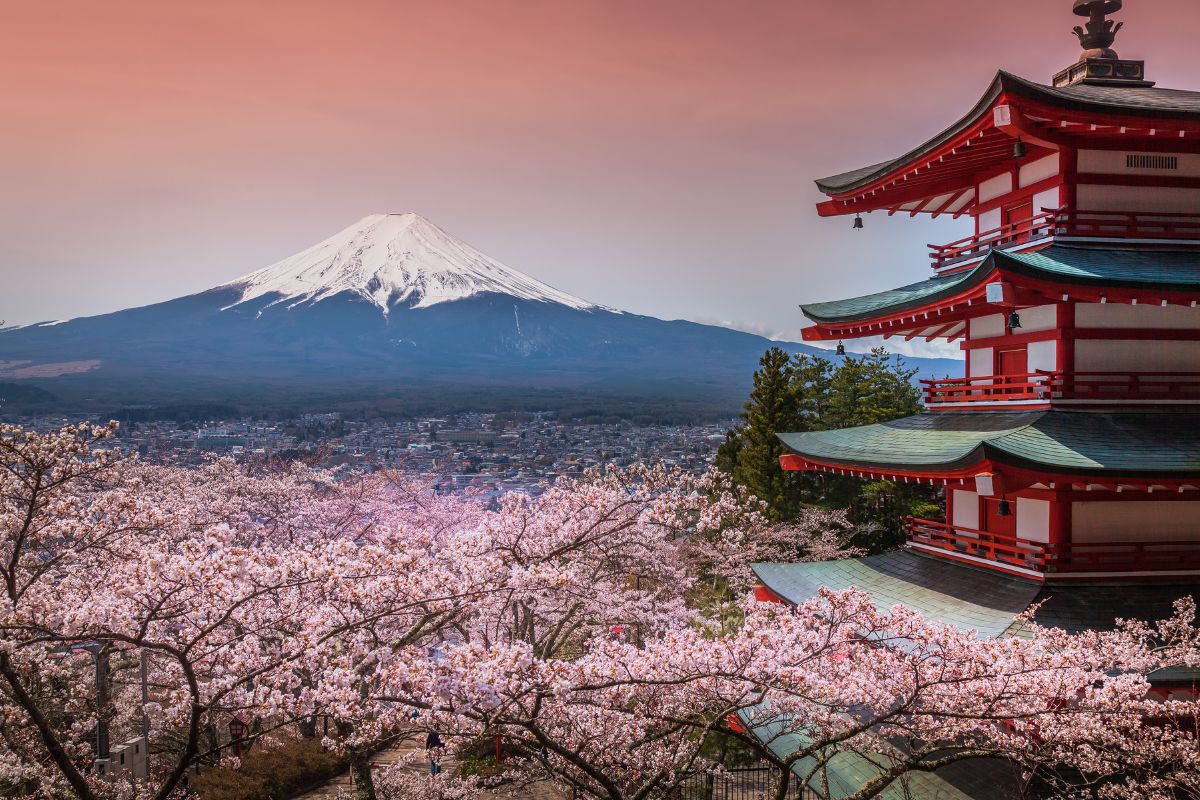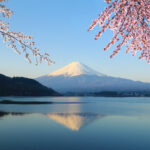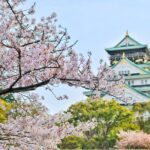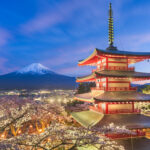Mount Fuji, or Fuji-san, is the most notable landmark feature in Japan. This mountain is an active volcano that rises up 12,380 feet (3,776 meters), creating a beautiful spectacle.

Not only is Fuji-san the tallest mountain in Japan, but it’s the 35th tallest mountain in the world. This beautiful sight is just 62 miles west of Tokyo, so you can easily see the mountain on a clear day.
While many locals and visitors choose to view the peak from afar, the slope can also be climbed in the summer. These climbs can take between 5-10 hours, but there are numerous trails to choose from that dictate this.
No matter which trail you pick, however, the climb is mesmerizing and always worth it. Fuji-san is culturally significant now, but has it always been?
Unsurprisingly, this mountain has a rich history, much like the rest of Japan. But what is that history, and what makes this peak so special?
History And Importance Of Mount Fuji
About Mount Fuji
Mount Fuji is Japan’s sacred mountain, and is one of the most prominent symbols of Japanese culture. Located on the island of Honshu, less than 65 miles from Tokyo, Fuji-san is also an active volcano.
This volcano’s summit is a wide crater, which is documented to have erupted numerous times in the past. Thought to have appeared around 600,000 years ago, the last eruption was documented in 1707.
The eastern face of Fuji-san collapsed about 2,300 years ago and created the Hoei-Zan to the mountain’s south-eastern side.
Historical And Religious Significance
As it stands now, Fuji-san is a UNESCO World Heritage Site. However, since the 7th century, this mountain has been considered sacred. In Shintoism, the emperor once ordered for the summit of the mountain to be destroyed.
This was to release the smoke beneath, which was described as an elixir. This mountain is also thought to be the home of the goddess of Mount Fuji – Konohanasakuya.
She is the deity of all volcanoes, which is why there are a number of shrines on the mountain and on the hiking trails up it. In the 12th century, Fuji-san’s upper half was a training center for ascetic Buddhism.
This is a lifestyle that is characterised by living with the abstinence from any kind of sensual pleasures, including warmth, food, shelter, and more. Along the upper half of the mountain, various pilgrim routes and shrines are located.
At the base of the mountain, the waterfalls, springs, lakes, and lava tree molds are revered. Even in the 11th century, art was created to depict such things. However, prints of sand beaches and views were created in the 19th century using woodblock printing.
It was these artworks that made Fuji-san a symbol of Japan and an internationally recognized landmark. This artwork even had a strong impact on Western art development.
The Importance Of Mount Fuji In Pop Culture Now

Today, Mount Fuji is an important icon in popular culture. Although this mountain is only open to the public for two months in the year (July and August), it is important year-round.
When open, many locals and tourists like to scale the mountain at night to get the best view of the sunrise – an unforgettable experience.
However, anyone who chooses to do this must be prepared and extremely cautious. A Japanese proverb states this: “He who climbs Mt. Fuji is a wise man; he who climbs it twice is a fool.”
Unfortunately, Fuji-san is not only known for its beauty. On the northwestern side of the commanding mountain is a 13.5 square mile space known as Aokigahara forest, or the Sea of Trees.
Another popular name for this area of forest is the Suicide Forest. This is an area known for suicides, though there are now numerous measures in the area to discourage anyone who is considering ending their lives.
Fuji-san might be one of the most popular mountains in the world in pop culture. This mountain is seemingly ever-present throughout popular culture, and is depicted in hundreds of works.
From 1974’s Fuji movie to The Fifty-three Stations of the Tōkaidō by Horishige, and even Fuji-inspired locations in Pokémon. There was also a scene in King Kong vs. Godzilla (1963) where the pair showdown on the sacred mountain.
This mountain is often also mentioned and seen in anime and manga, which is now loved globally. There are also a number of Japanese songs that are dedicated to the mountain.
Is Fuji-San Worth Visiting?
The incredible Mount Fuji is one of the must-see locations if you ever get to visit Japan. This mountain is visible from various spots and journey routes.
However, if you want to see the mountain from Tokyo, the weather will play a big role. Visibility should be fine in the summer, but with rain, fog, and snow, your hopes of seeing the mountain from a distance may be scuppered.
Ideally, you should visit one of the close locations to view the spectacle. These include places like Arakurayama Sengen Park, Oishi Park, or Lake Motosu. There, you will get stunning views of the mountain, and be able to enjoy it in its full splendor.
If you’re able to, you should absolutely make time for this beautiful and historical volcano. Don’t worry about it erupting, as the site is monitored closely.
Final Thoughts
Mount Fuji is one of the most special locations that you can visit in Japan. This site has both historical and religious significance, and is still popular for locals and tourists to visit every year.
The beauty of this peak has led to hundreds of art depictions, but it’s also seen in numerous works of literature and entertainment, such as movies and series.
As a historical and UNESCO World Heritage Site, Fuji-san is a must-see location for any visitor. If you want the honor of climbing it, be sure to visit at the right time of year.
- 16 Best Websites To Watch Japanese Movies With English Subtitles - May 11, 2023
- Is ZIPAIR The Best Airline For Traveling To Japan? - May 11, 2023
- Ryu Murakami Vs Haruki Murakami – Which One Should You Read? - May 11, 2023








